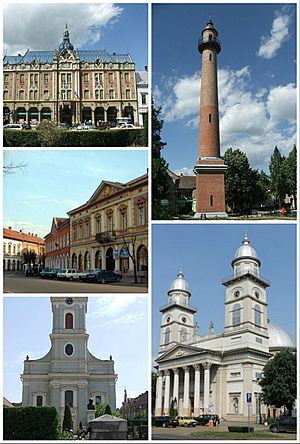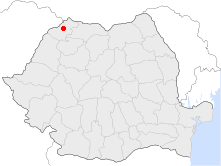Satu Mare facts for kids
Quick facts for kids
Satu Mare
Szatmárnémeti
|
||
|---|---|---|
|
City
|
||

Left to right: Dacia Hotel, Firemen's Tower, Vécsey Palace (art museum), Chain Church, Roman Catholic Cathedral
|
||
|
||

Location of Satu Mare
|
||
| Country | ||
| County | ||
| Metropolitan area | Satu Mare metropolitan area | |
| Status | County capital | |
| Founded | 972 (first official record as Villa Zotmar) | |
| Component villages | Sătmărel | |
| Area | ||
| • Total | 150.3 km2 (58.0 sq mi) | |
| Population
(2011)
|
||
| • Total | 102,441 | |
| • Density | 669/km2 (1,730/sq mi) | |
| Demonym(s) | sătmărean, sătmăreancă (ro) | |
| Time zone | UTC+2 (EET) | |
| • Summer (DST) | UTC+3 (EEST) | |
| Postal Code |
44xyz
|
|
| Area code(s) | +40 x61 | |
| Car Plates | SM | |
| Climate | Cfb | |
| Website | http://www.satu-mare.ro | |
Satu Mare is a city with a population of 102,400 (2011) and the capital of Satu Mare County, Romania, as well as the center of the Satu Mare metropolitan area. Mentioned in the Gesta Hungarorum as castrum Zotmar ("Zotmar's fort"), the city has a history going back to the Middle Ages. Today, it is an academic, cultural, industrial and business centre in northwestern Romania. The city is located at an altitude of 126 m (413 ft) on the Lower Someș alluvial plain, spreading out from the Administrative Palace at 25 October Square. The boundaries of the municipality contain an area of 150.3 square kilometres (58.0 sq mi).
From a geomorphologic point of view, the city is located on the Someș Meadow on both sides of the river, which narrows in the vicinity of the city and widens upstream and downstream from it; flooded during heavy rainfall, the field has various geographical configurations at the edge of the city (sand banks, valleys, micro-depressions).
The formation of the current terrain of the city, dating from the late Pliocene in the Tertiary period, is linked to the clogging of the Pannonian Sea. Layers of soil were created from deposits of sand, loess and gravel, and generally have a thickness of 16 m (52 ft)–18 m (59 ft). Over this base, decaying vegetation gave rise to podsolic soils, which led to favorable conditions for crops (cereals, vegetables, fruit trees).
The water network around Satu Mare is composed of the Someș River, Pârâul Sar in the north and the Homorod River in the south. The formation and evolution of the city was closely related to the Someș River, which, in addition to allowing for the settlement of a human community around it, has offered, since the early Middle Ages, the possibility of international trade with coastal regions, a practice that favored milling, fishing and other economic activities.
Because the land slopes gently around the city, the Someș River has created numerous branches and meanders (before 1777, in the perimeter of the city there were 25 meanders downstream and 14 upstream). After systematisation works in 1777, the number of meanders in the city dropped to 9 downstream and 5 upstream, the total length of the river now being at 36.5 km (22.7 mi) within the city. Systematisation performed up to the mid-19th century configured the existing Someș riverbed; embankments were built 17.3 km (10.7 mi) long on the right bank and 11 km (6.8 mi) on the left. In 1970, the embankments were raised by 2 m (6.6 ft)–3 m (9.8 ft), protecting 52,000 hectares within the city limits and restoring nearly 800 ha of agricultural land that had previously been flooded.
Flora and fauna
The flora associated with the town of Satu Mare is characteristic for the meadow area with trees of soft essence like wicker, indigenous poplar, maple and hazelnut. Grassland vegetation is represented by Agrostis stolonifera, Poa trivialis, Alopecurus pratensis and other types of vegetation.
The city's largest park, the Garden of Rome, features some rare trees that are uncommon to the area, including the pagoda tree, native to East Asia (especially China); Pterocarya, also native to Asia; and Paulownia tomentosa, native to central and western China.
Fauna is represented by species of rodents (hamster and european ground squirrel), reptiles, including Vipera berus in the Noroieni forest, and as avifauna species of ducks, geese, egrets, during passages and systematic occasional wanderings.
Climate
Satu Mare has a continental climate, characterised by hot dry summers and cold winters.
Twin cities
Famous people from Satu Mare
 Ernest Klein
Ernest Klein András Domahidy
András Domahidy Antal Bánhidi
Antal Bánhidi Gábor Darvas
Gábor Darvas Horváth Zoltán
Horváth Zoltán Aaron Teitelbaum
Aaron Teitelbaum Moshe Dovid Winternitz
Moshe Dovid Winternitz Daniel Prodan
Daniel Prodan Daniel David
Daniel David Ioan Mircea Paşcu
Ioan Mircea Paşcu Ovidiu Ioan Silaghi
Ovidiu Ioan Silaghi Ernie Grunfeld
Ernie Grunfeld
Images for kids
See also
 In Spanish: Satu Mare para niños
In Spanish: Satu Mare para niños














